Niger
Culture Name
Nigerien, Nigerienne
Orientation
Identification. From the early twentieth century until independence in 1960, the colony of Niger was part of French West Africa. Since the boundaries of the nation-state were imposed by European colonial powers, ethnic and cultural borders do not coincide with state boundaries. Since independence, there have been governmental efforts to promote a national culture.
Location and Geography. The area of this landlocked country is 490,000 square miles (1,267,000 square kilometers). One of the hottest countries of the world, Niger straddles the Sahara and Sahelian climate zones. Niger is essentially a flat country. Rainfall is rare north and east of the Air Massif but generally adequate in the west. The capital city is Niamey, with a 1998 population of approximately 500,000, located on the Niger River, which has a multiethnic population.
Demography. The population was approximately 9.2 million in 1998. The Hausa are numerically the predominant group, constituting approximately 53 percent of the population, followed by the Zarma-Songhai, 21 percent; the Fulani (Peul), 10 percent; the Tuareg, 10 percent; the Kanuri (Beri-Beri or Manga), 4.4 percent; and Arabs, Tubu, and Gourmantche, approximately 1.6 percent. In the precolonial era, Niger included regions of several "traditional" African kingdoms, empires, and states with varying degrees of stratification and centralization.
Linguistic Affiliation. There are five main ethnolinguistic groups, corresponding to the five national languages, in addition to French, the official language: Haussa, Anna-Songhai, Fulani or Fulbe, Tamajaq, and Kanuri or Beri-Beri. French is used primarily in official written governmental and international correspondence; the local vernacular languages are more often used in daily social interaction, markets, and trading.
Symbolism. The major groups share many Muslim beliefs and practices, including respect for Islamic/Koranic scholarship in Arabic. Much imagery comes from Islam, the major official religion. Most groups have retained elements of pre-Islamic cultural, symbolic, ritual, and political life, such as spirit possession, bilateral descent patterns, and spirit pantheons in local cosmological systems. Elements from nature also figure prominently in national symbolism. Millet stalks, for example, are popular motifs in embroidery on women's traditional blouses and appear on the emblem of a political party. The national flag's colors of green, orange, and yellow represent the different climate zones. In the increasingly important tourist industry, certain symbols and motifs have been adapted from local art forms, such as the Agadez Cross.
History and Ethnic Relations
Emergence of the Nation. Several precolonial empires had an impact on Niger, including the Songhai to the west and the Bornu Empire to the east as well as the Fulani Empire of Sokoto. In the nineteenth century, the first European explorers came to the area, searching for the mouth of the Niger River. Although French efforts at subjugation began before 1900, dissident ethnic groups, especially the Tuareg, were not conquered until the early twentieth century. The new colony was considered lacking in resources, and no paved roads or railroads were built between 1922 and 1944. No efforts were made to encourage river transportation, and the literacy rate remained among the lowest in Africa. Higher education opportunities were limited. The French constitution of 1946 permitted Niger to elect a representative to the French National Assembly and provided for decentralization
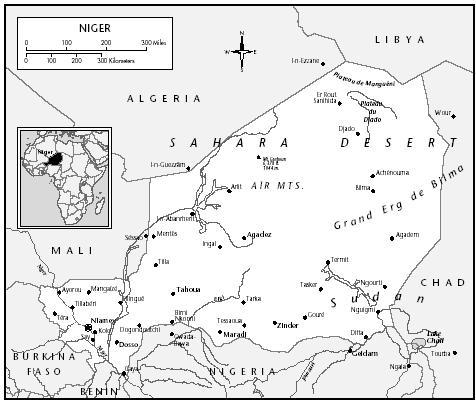
National Identity. The population is affected by cultural elements from North Africa as well as Africa south of the Sahara. In general the ethnic groups tend to be distributed according to region. While the national identity incorporates many elements from all the regional and cultural/ethnic influences, the recent tensions between north and south and east and west have been based on distinctive aspects of ethnic and geographic regional experience. Many of these tensions are rooted in uneven development of the different regions.
Ethnic Relations. Ethnicity is an important factor in disunity and conflict in contemporary Niger. Political tensions exist between sedentary peoples and nomads. However, apart from military antagonism between the Zarma-Songhai and the Tuareg in the nineteenth century, the people have little historical basis for exclusively ethnically rooted hostility and conflict. Contemporary ethnic conflict stems largely from deliberate decisions of the nation's
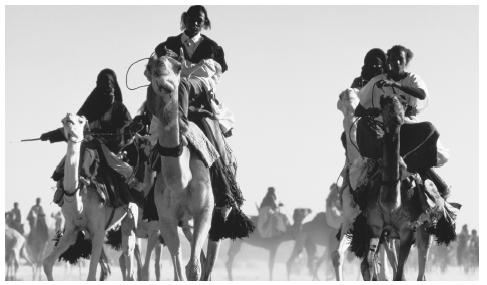
After independence, the new regime was dominated by educated Zarma, who were concerned with the demographic and economic imbalance between their group and the more numerous and commercially minded Haussa. In the first fifteen years after independence, the policies of the new regime intensified ethnic consciousness. Although the military government that took power in 1974 attempted to suppress that consciousness, ethnic identity has continued to mold political and economic demands. Subdivisions within each ethnolinguistic and cultural group also exist and occasionally are more salient than differences between ethnic groups. Precolonial societies often distinguished nobles and Islamic scholars from commoners and slaves; merchants from farmers herders, and fishers; and warriors from producers.
Urbanism, Architecture, and the Use of Space
Despite growing migration to the towns and the recent growth of the capital city, Niger remains overwhelmingly rural. Outside the capital city, architecture and the use of space reflect traditional regional and sedentarized-nomadic differences. In both rural and urban areas, architecture also reflects social stratification. Throughout much of the rural south, west, and east, there are adobe mud houses and a few concrete tin-roofed houses of functionaries and teachers. In much of the rural north, there are semi-sedentarized nomadic camps with tents of various materials (grass, animal hides) interspersed with adobe mud houses. Tents have portable walls, which are removed and transported for nomadic migration with herds. The greater degree of sedentarization in a community, the more common the adobe mud houses. In semi-nomadic Tuareg communities, women build and own the tent and men build and own the adobe house. In the tent, there is gender-based symbolism: for example, the left side of the interior of a Tuareg tent is associated with the married woman owner and her belongings and the right side is associated with her husband. As houses become more common as a result of sedentarization, there are corresponding changes in property relations between the sexes. In many communities, mosques are surrounded by the homes of traditionally aristocratic, chiefly, and Islamic scholar families. Homes of families of traditionally lower or ambiguous status are located farther from the mosque and its surrounding neighborhood. Another important feature in the countryside is the widespread opposition between the settled community (village or camp) and the wild. There is the idea of the settled community as a human habitation and center of civilization, as opposed to the unsettled, wild areas surrounding it that are believed to be inhabited by spirits. People are believed to be vulnerable to the influence of the spirits of the wild on certain specified occasions, such as during life transitions or during travel. The spirits of the "wild" spaces must be controlled before people engage in activities that alter their domain. In Niamey, most families' houses also tend to be of the standard adobe mud type, usually rented, although there is variation according to nationality and socioeconomic class. Many Europeans in Niamey inhabit buildings locally called "villas," that are made of concrete and often have running water, electricity, and air-conditioning. In Niamey there have been increasing gaps between the standard of living, income, and comfort of most Nigeriens and that of many foreign residents. Europeans and a few well-to-do Africans tend to reside in neighborhoods high on a hill, called the Plateau, and near the river in European-colonial concrete villas and Western-style apartments. Also on the Plateau are government offices, ministries, the presidential palace, and the presidential guard as well as the offices of many international aid agencies and embassies.
Food and Economy
Food in Daily Life. Millet, sorghum, and beans are the major food crops, and peanuts and cotton are the major cash crops. Rice is grown along the banks of the Niger River. Millet is the basic daily staple for most rural people in all regions, followed in importance by corn, sorghum, rice, macaroni, beans, cowpeas, cassava, and wheat dishes such as couscous. Rice is a "status" food that is served at rites of passage, holidays, and other special occasions. Millet dishes vary in style but usually are prepared as a "paste" or stiff cooked porridge dough and covered with a vegetable sauce that occasionally contains small pieces of meat. However, most meat is served apart from sauces, grilled and eaten on the side on special occasions. In the northern Air region, millet often is also served with goat's or camel's milk. Also popular in the north is cheese made from goat's milk. Food taboos include a nationwide avoidance of pork and specific taboos observed by different groups.
Food Customs at Ceremonial Occasions. Important ceremonial occasions at which special meals
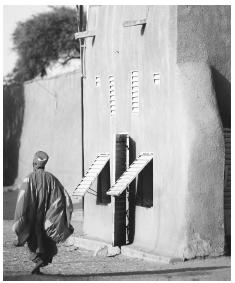
Basic Economy. Niger is one of the world's poorest nations, with a per capita income of $220 (U.S.) in 1995. The northern zone is devoted primarily to pastoral nomadism involving camels, cattle, sheep, and goats. In the Air Massif there are pockets of oasis gardens that require constant irrigation. The southern Sahelian zone is devoted to agropastoralism, which at the fringe of the Sudanian zone becomes essentially agriculture. Despite efforts by the government to increase agricultural production and the development of uranium mining, the gross national product has declined sharply.
Niger has been plagued by ecological disaster, economic crises, and political uncertainty. After the drought of 1968–1974, the government attempted to make the country self-sufficient in food production. This was achieved in 1980, but another drought in 1984 caused food shortages. Austerity measures imposed by the World Bank and the International Monetary Fund further weakened the economy, bringing shortages and unemployment. In more arid regions, livestock production dominates with the raising of cattle, camels, sheep, and goats. There is fishing on the Niger River and Lake Chad, with dried fish sold widely.
Commercial Activities. There are permanent markets in the major towns and market days in rural communities. Much commerce is conducted by truck and traditional camel caravan trade between Niger and Nigeria. Goods in local markets include fresh produce such as fruits and vegetables, dried river fish, canned goods from Algeria, household supplies and tools and cloth from as far away as China, spices, perfumes, and traditional medicines from Algeria, Nigeria, and Mecca. Many Haussa and Zarma-Songhai women cook and sell snack foods by the side of the road. Some women manufacture knitted items and engage in leatherwork.
Major Industries. Mining accounts for nearly 20 percent of the gross domestic product. Uranium exports are a major source of national income. Uranium mines opened in 1971, and output reached a peak in 1981. Declining demand and falling world prices then led to a reduction in output. It is estimated that Niger has 10 percent of the world's uranium reserves. Coal is used to generate electricity for the mining towns. Other important minerals include tin-bearing cassiterite, iron, tin, coal, phosphates, gold, and salt. Manufacturing consists mainly of food processing, textile production, and leather tanning. Tourism has become important.
Trade. The traditional caravan trade, while it has diminished in importance, is still conducted by Tuareg men. The men go east to Bilma to trade millet for salt and dates and then go south to Kano and other parts of Nigeria to trade the salt and dates for household tools, luxury goods such as cloth and spices, and more millet.
Division of Labor. In rural communities, many work roles still correspond to traditional patterns of age, gender, and social class. The major cultural and ethnic groups are characterized by a marked degree of specialization in labor that derives from their complex precolonial hierarchical, stratified social organization. Those social orders featured hereditary, endogamous occupational groupings with traditionally performed distinct roles as well as relationships of fictive kinship and mutual dependence. In the past, slavery was important. Age-based roles cut across this system in the form of fictive kinship and apprenticeship. Because of their joking relationships with persons of aristocratic origin, smith-artisans and oral historians ( griots ) often are referred to metaphorically as their "cousins" or "little sisters (brothers)." Young children begin training for the specialized tasks of their social background, such as working the forge, in an apprenticeship, usually under the same-sex parent or another older close relative. Social strata with varying tributary and servile origins formerly served aristocratic or "noble" patrons, and even today in many rural areas, families of aristocratic origins are still attached to their inherited smiths and griots . However, prestigious descent no longer always corresponds to socio-economic prosperity, and many families of noble origin now have difficulty supporting their client families. In the towns, many of these "client-patron" relationships are breaking down. Particularly important today are arts and crafts specialists. Among the Haussa, there are metalworkers, leatherworkers, griots, and other specialized hereditary strata. Among the Tuareg, smith-artisans in the countryside manufacture jewelry, weapons, and household, gardening, and herding tools for nobles and serve as ritual specialists, providing music at nobles' name days, weddings, and other festivals as well as acting as go-betweens for marriage arrangements and as political intermediaries for traditional chiefs. In the towns, many Tuareg smith-artisans are active in the market trade, adapting their traditional silver, wood, and leather works for European tourist and African functionary tastes and sometimes working in gold. Griots and smith-artisans exert much informal power through their critical social commentary. Also important among all groups are Koranic or Islamic scholars, often called marabouts , who serve as religious scholars and scribes and, in the countryside, combine legal, medical, and religious professions.
Social Stratification
Classes and Castes. New classes are emerging, particularly in the towns. While marriages still tend to be endogamous in the countryside, there is increasing intermarriage in the towns and monetization has disrupted many old client–patron rights and obligations. Functionaries may be of diverse
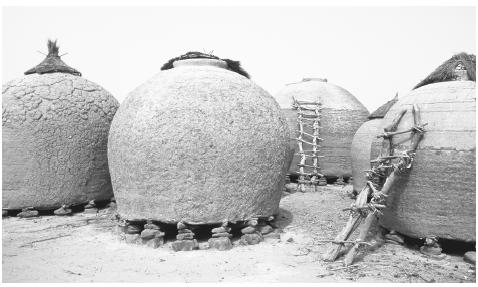
Symbols of Social Stratification. Traditionally, aristocratic people were distinguished not by vast differences in wealth or standard of living but by exterior verbal and nonverbal symbols of body, dress, and ornamentation. These symbols included cultural values emphasizing reserved, dignified conduct such as controlled and indirect speech; bodily signs of ease such as soft hands and long fingers set off by ornate rings; a portly well-nourished body; layered, voluminous cloth and, for men, an elaborately wrapped headdress; and heavy and intricately worked silver and gold jewelry for women. Certain material items were forbidden to all but the aristocracy. Griots and smith-artisans in these societies were expected to lack reserve, dress less modestly; and say what nobles could not. Throughout the country, however, there were minimal differences among the social strata: Within each group, all spoke the same language, ate similar foods, and lived in housing that, except for chiefs' residences, was not radically different. The external class and caste symbols, however, necessitated a relatively more comfortable lifestyle conspicuous consumption for high-status person. These distinctions also included greater monopoly over resources such as land, livestock, and trade. Despite these differences, there has always been the possibility of mobility. Today many external symbols no longer correspond to social origins, and wealth does not always coincide with prestigious status.
Political Life
Government. Niger is a republic, with recent alternations between military and transitional parliamentary governments. In principle, a president is elected for a five-year term through universal suffrage. The eighty-three-member Assemblée Nationale , which was inaugurated in 1993, was suspended in 1996. The next elections were scheduled for the years 2000 (legislative) and 2001 (presidential).
Leadership and Political Officials. The national government is headed by an appointed prime minister and the Council of Ministers. Local governmental organization is based on seven departements , or provinces, headed by prefects (similar to governors), thirty-two arrondissements , and one hundred fifty communes . The first president was overthrown by a military coup because of widespread discontent with the government's failure to distribute drought relief effectively from 1968 to 1974. After the adoption of a new constitution in December 1992, in early 1993 Niger conducted its first multiparty presidential and legislative elections since independence. The constitution provided for a semi-presidential system of government in which executive power is shared by the president of the republic, who is elected by universal suffrage for a five-year term and a prime minister named by the president. The unicameral legislature has eighty-three deputies elected for a five-year term under a system of proportional representation.
After a coup in 1999, the head of the presidential guard, Daouda Malam Wanke, was named president and head of the National Council for Reconciliation. This coalition was expected to lead Niger for a nine-month transition period. Following this period, Tandja Mamadou was sworn in as president, returning Niger to civilian rule.
Social Problems and Control. Although the main security forces consist of the army, the gendarmerie (rural paramilitary police), and the national police, there are alternative formal and informal mechanisms for dispute settlement and social control, particularly in rural areas. In the towns, there is a secular court system based on French law. Civil and criminal cases that do not involve security-related acts are tried publicly. Defendants have the right to be present, confront witnesses, examine the evidence against them, present evidence of their own, and choose a lawyer. Minors and defendants charged with crimes carrying a sentence of ten years or more are eligible to be defended at public expense. Defendants and prosecutors may appeal a verdict to the Court of Appeals and then to the Supreme Court. The Court of Appeals reviews questions of fact and law, while the Supreme Court reviews only the application of the law. Cases involving divorce or inheritance may be heard by a traditional chief or a customary court. Customary courts in large towns and cities are headed by a legal practitioner who is advised by an assessor who is knowledgeable about the society's traditions. The judicial actions of chiefs and customary courts are not formally regulated. Cases that are not resolved by chiefs or customary courts can be appealed to the formal court system. While there are no official religious courts, in the countryside plaintiffs first take disputes to local councils of Islamic scholars, elders, and chiefs, who arbitrate many local land disputes, marital conflicts, and thefts, sometimes referring to Koranic law. Additional, informal means of social control include gossip, praise songs, and certain "pollution beliefs" involving theft and divine retribution.
Military Activity. The president is commander in chief of the armed forces. There is a two-year period of conscription.
Social Welfare and Change Programs
In the industrial sector, the labor federation, the National Union of Nigerien Workers (USTN), includes 423 unions representing 70 percent of the wage earners. Most of the workforce, however, is employed in subsistence agriculture and herding and artisan work and is not unionized or salaried. Thus, the majority of the USTN membership is made up of civil servants, teachers, and employees of state-owned corporations such as the national electrical utility (NIGELEC). The USTN and the Teachers Union have stated policies of political autonomy, but all unions have informal ties to political parties. There are a hundred or more trade associations. There is also an office approximating Social Security for retiring functionaries.
Nongovernmental Organizations and Other Associations
The vast majority of people are more affected by customary informal organizations or foreign aid organizations, such as insurance-like pooling and "community chests," and by religious-sponsored charity or tithing.
Gender Roles and Statuses
Division of Labor by Gender. Although women traditionally do not take part in official political decision making and there is some division of men's and women's worlds, the local cultural ideology defines these conditions as complementary rather than unequal. Men tend to be characterized as the breadwinners and perform labor in the "public" and "official" domain as opposed to the "private and domestic" and "unofficial" domains. Men tend to travel more widely than women to do migrant labor and on caravan expeditions. Women tend to cook, act as the primary caregivers for children and aged persons, and do domestic work such as crushing
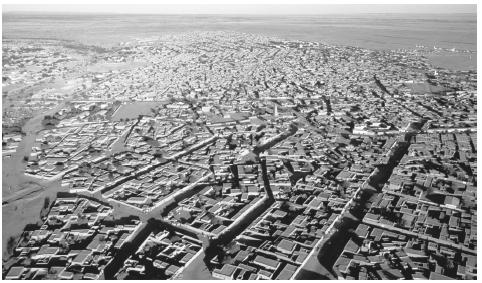
The Relative Status of Women and Men. In 1993, the government appointed five women to ministerial positions in a twenty-eight-member cabinet. Women's organizations and other human rights groups conduct educational campaigns to increase the participation of women in the official political process. The traditional practice of husbands' casting their wives' proxies was widely used during the National Assembly elections and the first round of presidential elections. Human rights groups have tried to eliminate this practice. Despite variations among the different ethnic groups in the traditional status of women, women do not enjoy official equal legal status with men nationally. While the head of household has certain legal rights, divorced or widowed women, even those with children, are not considered the heads of the households. Women's rights groups have been attempting to strengthen women's rights in inheritance, land tenure, and child custody and to end the practice of repudiation, which permits a husband to obtain an immediate divorce without having further responsibility for his wife and children. There is a small but increasing number of women professionals. In some regions, particularly the towns, domestic violence against women and children is widespread. Families often intervene, however, and divorce can be granted for physical abuse. In some towns, prostitution is the only economic alternative for a woman who wants to leave her husband. Some women own property: for example, some urban women own houses that they rent, and rural Tuareg women inherit, own, and manage livestock and date palms. Recently, there have been isolated incidents of violence against women for religious reasons.
Marriage, Family, and Kinship
Marriage. First marriages are almost always arranged by the parents in both rural and urban communities. Usually, there are no "forced" unions;
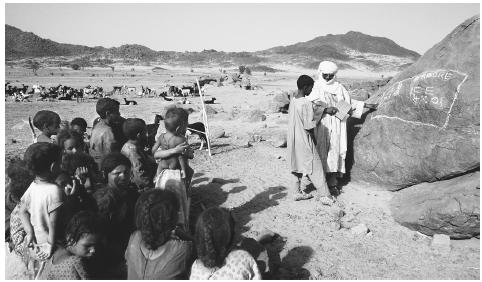
Domestic Unit. In general, the compound, either walled or fenced in, is the basic domestic unit; in rural areas, it is also the basic unit of production. Among the rural Haussa, compounds are organized around a postmarital residence pattern of a married father and his sons with their wives in a large extended household that is organized around traditional farming labor. Among the Tuareg, rural compounds tend to be somewhat smaller, ideally constituting more nuclear households, but adjacent to or near compounds of the married couple's parents. Initially, there are two to three years of uxorilocal residence, followed by possible virilocal residence after the paying of the bride wealth and groom service and stable marriage if the couple chooses to move. In the major towns, compounds tend to be located farther from kin than they are in the countryside, and many unrelated persons may rent within the same compound.
Inheritance. Many groups practice patrilineal Islamic-influenced inheritance. There are also bilateral inheritance practices and much informal preinherited property in the form of gifts. Some groups have alternative, non-Koranic forms of inheritance.
Socialization
Infant Care. Infants generally are not placed in separate spaces to sleep and play; they usually are kept in close proximity almost as an extension of the mother's body. The mother usually carries the infant on her back in a cloth or in a goat-hide sling over the shoulder. Most infants are breast-fed. As infants mature, older female siblings usually take over much of the child care. Parents often play with and sing songs to babies who cry. Other games include playing at "riding" camels or horses. Babies and toddlers are allowed to explore and wander widely. Weaning occurs at approximately twoand-a-half years of age in most groups.
Child Rearing and Education. Early childhood is characterized by rather lax discipline. Children are permitted considerable verbal license toward certain persons. Among the Haussa particularly, children act as important go-betweens and intermediaries for adults, often entering spaces where adults cannot go. Cultural values that are inculcated early in childhood include an emphasis on generosity and sharing, respect toward adult authority figures such as Islamic scholars and elders, and careful observation of adult tasks in apprenticeships. There are clearly demarcated rites of passage; name days, popularly called by the French term bapteme , are celebrated among all groups one week after a birth and the conferring of a Koranic name on the child. The child's hair is shaved to sever ties with the spirit world. In rural areas, male circumcision usually is performed by a specialist called a barber when boys are three to seven years old. The next important rite of passage is marriage. General similarities include the practice of secluding the bride, sharp social and ritual spatial segregation of the bride's and groom's families; and the use of henna on the hands and feet. Wedding rituals often include pre-Islamic as well as Islamic ritual phases.
Higher Education. In rural areas, many families discourage girls from pursuing an education beyond primary school. At the one university, the University of Niamey, males predominate. Among some groups, particularly the nomads in the north, many families opposed all secular schools until recently, fearing them as sources of government control and cultural change.
Etiquette
General rules of conduct include the importance of greetings, many of which are elaborate. Among all ethnic and cultural groups, it is considered extremely rude to approach someone with a question or statement without a preliminary greeting. French business formats and salutations are the rule. Indirect expression is the ideal, particularly between high-status persons. It is considered rude to overtly refuse to do something or strongly contradict someone. Dress should be modest and neat among both men and women. Recently, there has been violence against women wearing clothing considered immodest by Islamic reformists. Among many persons, ideally some bodily distance is maintained, although close friends of the same sex frequently walk arm in arm.
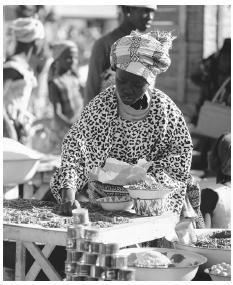
Religion
Religious Beliefs. Islam is the religion of 98 percent of the population, followed by traditional religions and Christianity. There is a great deal of religious tolerance, and many Islamic beliefs and practices are strongly influenced and modified by the local cultures. Many local cosmologies and rituals have both Islamic and pre-Islamic elements. Haussa and Zarma-Songhai rituals feature particularly elaborate spirit pantheons. Pre-Islamic myths and rituals coexist in local historical consciousness with Koranic traditions.
Religious Practitioners. Islamic scholars combine medical-psychiatric and legal skills, particularly in rural communities. Marabouts also enact important Muslim rituals, such as animal sacrifice, naming, marriage, and funeral condolences. A specialist called an imam leads the call to prayer. In rural Tuareg society, smith-artisans play important ritual roles. Additional religious specialists include zima spirit mediums among the Zarma-Songhai, bori (possession) leaders among the Haussa, and some persons in all groups who are believed to bring rain.
Rituals and Holy Places. Rites of passage are prominent. Spirit possession exorcism and mediumship rituals also are widely practiced. Other ceremonies take place on official Muslim holidays. The Friday prayer takes place at a special prayer ground near the mosque. In parts of the northern Air Mountain region, there are sacred places associated with prominent marabouts and more specialized holy clans claiming descent from Muhammad called icherifan , and places of pilgrimage where marabouts travel for conferences. Throughout the countryside, designated places are demarcated as spaces for smith-artisans and herbalists to conduct ritual preparations and communicate with spirits, such as the ruins of ancestral houses and special natural features (rocks, medicinal trees). Tombs of prominent marabouts usually are set apart from ordinary cemeteries.
Death and the Afterlife. Islam influences beliefs and practices surrounding death. Mortuary ceremonies consist of preparation of the body, burial, and a series of ritual meals with Koranic readings and alms giving called condolences. Burial takes place soon after death. The body is washed and wrapped in a white shroud and then taken by men chanting Koranic liturgical music to the grave site. A marabout reads verses from the Koran and leads the prayer. Upon the internment, two lines are formed so that the angel of death may pass through. Women remain at home during this phase but are very active in mortuary rites. Condolences consist of ritual meals held one week after death and repeated at various intervals. At the initial condolence ceremony, the marabout officiates, transmitting his religious blessing or benediction (called al baraka ) to the guests. Beliefs concerning the afterlife include pre-Islamic elements. It is believed that an angel weighs good and evil deeds at a final judgment and that the deceased subsequently enters paradise or various levels of hell. Alongside these beliefs, however, traditional beliefs regarding ancestors, souls, and spirits persist.
Medicine and Health Care
There are two broad categories of health care. The first includes government-sponsored institutions with workers trained in Western biomedicine: several hospitals in the major towns and in the capital city of Niger, clinics in rural areas, mobile immunization health units, and traditional healing specialists. The second category consists of "traditional" or local healing specialists and practitioners: Koranic/Islamic scholars and a more specialized group who claim descent from the Prophet; non-Koranic healers whose means include divination and herbal medicine; bone setters; and various ritual adepts or cult leaders, such as musicians, in spirit possession and mediumship. Some patients alternate between and combine treatments from the various healers, and there are shortages of medicines such as antibiotics. Some rural people, particularly women, are hesitant to use hospitals and clinics. There have been sporadic efforts to integrate some traditional healers, such as herbal medicine women, into the Western biomedical establishment through training programs and certification. In Niamey, there has been a proliferation of private practices, but private medical insurance is not available to the vast majority of people. Many uncontrolled medical substances are hawked on the streets. The risk-sharing arrangements that exist are primarily employer-based programs in urban areas. In rural communities, traditional practitioners remain important. Islamic scholars heal with verses from the Koran and perform Koranic ritual divination and social and psychiatric counseling. Those healers, sometimes called "sorcerers," often divine with plants, perfumes, cowrie shells, and other means. Herbalists work with tree bark, leaves, and roots and conduct ritual incantations and sometimes serve more specialized functions such as marital counseling. Spirit possession specialists provide music that is believed to enhance communication with the spirits that possess the person in trance. Possession rituals are usually public events, with musicians, audience, and trance adepts all interacting in a form of group therapy.
Secular Celebrations
National holidays include New Year's Day, 1 January; Niger Independence Day, 8 August; and Niger Republic Day, 18 December. Government offices, including foreign embassies, are closed on those days, which feature parades, political speeches, and folkloric performances. There are also several Christian and Muslim holidays.
The Arts and Humanities
Support for the Arts. There is great appreciation for the arts and literature. Visual art, theater, and musical performances are connected to the traditional but changing roles of artisans and oral historians. The National Museum and several privately and publicly-funded artisan workshop and cooperatives support jewelry, leather work, pottery, and other art production. There are prominent modern literary authors, essayists, poets, and painters. A well-known Tuareg painter, Rissa Ixa, founded the Association for the Promotion and Development of Traditional Arts and Cultures in Niger. A Haussa painter in Maradi produces paintings that comment on local social and political issues, and there are many novelists.
Literature. Literary production includes both traditional oral and verbal art forms and contemporary written forms that appear both in French and in local vernacular languages. Niger has a vast repertoire of oral art, based on traditions of oral historians and smith-artisans, much of which has been transcribed and published by the national press through the support of artists and scholars connected to the University of Niamey. This repertoire includes battle and epic praise poetry, love poetry, current political songs, proverbs, and riddles. Zarma-Songhai and Haussa plays often address current events.
The State of the Physical and Social Sciences
Niger has a number of prominent researchers, particularly in history, sociology, ethnology, and literature. The Centre National de Recherches en Sciences Humaines conducts research, mostly in the humanities but also in the sciences and social sciences, and publishes Etudes Nigeriennes . The Musee National is also nominally the responsibility of the Centre. The University of Niamey was created in 1974, and the Centre, now known as IRSH or l'Institut des recherches en sciences humaines (Human Sciences Research Institute) was attached to it. CELTHO (Center for the Study of Oral History) is sponsored by the United Nations and the Organization of African Unity.
Bibliography
Charlick, Robert. Niger: Personal Rule and Survival in the Sahel , 1991.
Decalo, Samuel. Historical Dictionary of Niger , 3rd ed., 1997.
Fuglestad, Finn. A History of Niger 1850–1960 , 1983.
Human Rights Watch. Niger: Human Rights Report , 1993.
Masquelier, Adeline. "Narratives of Power, Images of Wealth: The Ritual Economy of Bori in the Market." In Jean Comaroff and John Comaroff, eds., Modernity and Its Malcontents , 1993.
Rasmussen, Susan. Spirit Possession and Personhood among the Kel Ewey Tuareg , 1995.
——. The Poetics and Politics of Tuareg Aging: Life Course and Personal Destiny in Niger , 1997.
Schmoll, Pamela. "Black Stomachs, Beautiful Stones: Soul-Eating among Haussa in Niger." In Jean Comaroff and John Comaroff, eds., Modernity and Its Malcontents , 1993.
Stoller, Paul. Fusion of the Worlds: An Ethnography of Possession among the Songhay of Niger , 1989.
——. Embodying Cultural Memories: Spirit Possession, Power, and the Hauka in West Africa , 1995.
——, and Cheryl Olkes. In Sorcery's Shadow , 1987.
U. S. Department of State, Bureau of African Affairs. Niger: Background Notes , 1994.
Weaver, Marcia, Holly Wong, Amadou Sekou Sako, Robert Simon, and Felix Lee. "Patient Fees in the Niamey Hospital." Social Science and Medicine 38: 563–574, 1994.
—S USAN J. R ASMUSSEN
: )
Peace Niggas Im Out
one last thing at least try to write their language and explain it. is it different form hausa
The information was good but please add this few extra detials.
thak you.
enah.in
I enjoy lot there and people are very kind and i did shopping also there i bought traditional cloths.
but the weather is to hot it's around 45 degree i was there from April to mid of june.
Before going Niger i seen from TripAdvisor and GOV.UK they have mentioned that's Niger is not good place so much crime and kidnapping is there but i did not see anything wrong there i don't which place they have talked initially i was not going anywhere but later have started and to be Frank it was good nothing was happens there even i have started to watch to Niamey in night i was fully shape nothing wrong happened.
People are very kind.
And I was staying in Grand hotel of the Niger it's good hotel and it's near to Airport hardly 25 mins from Airport.
But one thong would like to tell you when you reached to the Airport of Niamey the security guard has asked to, he said give me some dollar for coffee so i told i don't have money everything is managed by company they don't have give any money. So that was only seamless otherwise it was good.
So over all you can go there and Enjoy.
So it was great experience to been there.